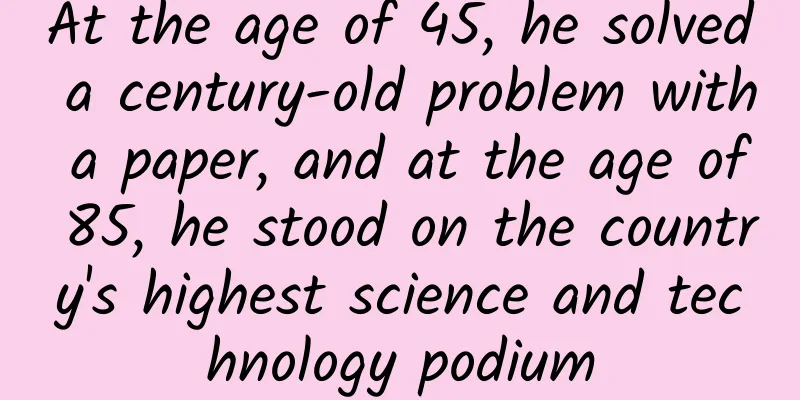At the age of 45, he solved a century-old problem with a paper, and at the age of 85, he stood on the country's highest science and technology podium

|
From traveling across mountains and rivers to carry machines for measurement, to aerial remote sensing and then satellite remote sensing, the field of surveying and remote sensing is changing rapidly with the iteration of technology. "My life's work is to make surveying and mapping digital, intelligent, automated, and real-time." Although he is 85 years old, Academician Li Deren is still on the move. With his unremitting thinking and unremitting innovation, he has led my country to achieve a fundamental transformation from traditional surveying and mapping to information-based surveying and remote sensing, and has put China on the road of innovation to become a remote sensing power. In 2024, this "master" of China's surveying and mapping industry will win the country's highest science and technology award. One cannot waste one's life "Love China, prosper my country, study hard when young, and have a prosperous family. Play music, spread calligraphy, respect teachers and friends, and be filial. Live in harmony with neighbors, support the young and respect the elders... Work hard and be frugal, and your family will prosper." Li Deren knew the 80 words in the "Li Family Instructions" by heart. Whether he was studying as a child, pursuing further studies when he grew up, or encountering difficulties at work, Li Deren often used the "Family Instructions" to encourage himself. Li Deren graduated with a bachelor's degree in 1963 and was admitted to a master's program with high scores. However, he was disqualified from admission because of a "false" document in his file. After that, Li Deren faced 15 years of adversity in his life. Even when he was sent to the May 7th Cadre School, he still insisted on studying. In 1978, the country resumed graduate student enrollment, and Li Deren finally returned to campus. That year, he was already 39 years old. “Whether in good times or bad times, we must have confidence and self-respect, just like a piece of white cloth, which can be made into a hat for others to wear, or a cushion for people to sit on... People cannot waste their lives, they must make some contribution to the country.” His patriotism and his tenacious will allowed him to stand firm in the face of the storms of the times. At the entrance of Wuhan University's Surveying and Mapping Laboratory, there is a statue of Li Deren's mentor Wang Zhizhuo. Wang Zhizhuo, Xia Jianbai and Chen Yongling are known as the founders of China's surveying. They worked together to improve the backward situation of China's surveying at that time. Li Deren still remembers his acquaintance with his mentor Wang Zhizhuo. During his studies, he found several errors in Soviet textbooks, so he wrote three academic articles to explain them and asked his classmates to pass them to Wang Zhizhuo. To Li Deren's surprise, Wang Zhizhuo, who was the dean of the department at the time, invited him to his home to discuss until late at night. ▲In 1991, Li Deren worked at the Swiss Federal Institute of Technology in Zurich In 1978, the country resumed the postgraduate entrance examination, and the 39-year-old Li Deren was admitted to Wang Zhizhuo's graduate school as he wished. Three years later, Li Deren obtained a master's degree with excellent results. In 1982, Li Deren had the opportunity to study in the Federal Republic of Germany. With the recommendation of Wang Zhizhuo, he studied under Professor Ackerman, an internationally renowned photogrammetry and remote sensing scientist. At that time, Ackerman gave him a very challenging problem in the field of aerial surveying - to find a theory that can distinguish between accidental errors, systematic errors and gross errors at the same time. The error problem was a global problem at the time. Li Deren worked more than ten hours a day and finally completed his doctoral thesis in German in just one year and four months. His doctoral thesis defense score was 1 point + 5 stars, which became the highest score record of Stuttgart University at that time. At a party before returning to China, Professor Ackerman made an exception and announced Li Deren's thesis comments. Professor Gravarent, an internationally renowned theoretical geodesist, wrote: "I am excited about this article. It solves a problem that has plagued measurement theory and practice for more than a hundred years." Because he raised the theory of gross error discovery to the theory of distinguishing gross errors from systematic errors, he won the Lufthansa Aviation Surveying Award of the Federal Republic of Germany. Today, every country in the world uses Li Deren's theory when calibrating aerial survey adjustment systems. When he graduated from Germany, many foreign scientific research institutions extended olive branches to Li Deren. Faced with the invitation, he resolutely returned to China. What Li Deren thought in his heart was just as his wife Zhu Yixuan wrote in a letter: "You are a cow, eating the country's grass until you are 45 years old. Now you should come back to milk. This is the time for you to make contributions." From lagging behind to the forefront In March 1985, Li Deren stood on the podium of his alma mater. He taught three courses to undergraduates without considering his title or salary. A year later, he was promoted to professor. In 1991, he was elected as an academician of the Chinese Academy of Sciences. In 1994, he was elected as an academician of the Chinese Academy of Engineering and the Eurasian Academy of Sciences. In 1997, he was elected as the president of Wuhan University of Surveying and Mapping, until the school merged with Wuhan University in 2000. Soon after returning to China, Li Deren received a difficult surveying task - mapping the border between China and a neighboring country in a minefield. The long border line is either hidden in the mountains or distributed in dangerous places, and there may be mines buried underground. It is not enough to quickly find out the situation in a short period of time by manual surveying alone. Li Deren proposed "putting GPS on the plane" and using the "GPS aerial triangulation" technology, he quickly completed the border mapping task without ground control points. This was the first time that a Chinese person mapped a border using an airborne GPS system. Since then, he has used this technology to complete aerial surveys and mapping of Hainan Island, Tiger Leaping Gorge and many other places in my country. At the turn of the century, Li Deren was extremely worried about the fact that my country was lagging behind others in satellites, aviation, ground systems, etc. In his opinion, "there is innovation only when there is a leap forward. If we just follow others and do repetitive research, we will always lag behind. China must have its own high-resolution satellite." In 2002, Li Deren, as the leader, proposed to the country to "build a high-resolution earth observation system in my country." This suggestion was affirmed, officially approved in 2005, and listed as one of the 16 major national projects in my country. After 15 years, the "GF Special Project" has achieved remarkable results, basically meeting the major needs of economic development, national defense construction and people's livelihood, and making my country's satellite remote sensing and its applications catch up with the world's advanced level. In 2020, the related research "Key Technologies and Applications for High-Precision Intelligent Processing of Sky-Earth Remote Sensing Data" won the first prize of the National Science and Technology Progress Award. "This achievement is the result of our use of Chinese wisdom, mathematics and process control methods to reach world-class level under the condition of limited components," said Li Deren proudly. From relying on foreign imports for 85% of satellite data to achieving 85% self-sufficiency, and then exporting to other countries, my country's surveying and remote sensing technology has gradually moved from backwardness to the forefront of the world, and established a true "Chinese global observation system". Driven by the driving force of independence and self-reliance, Li Deren also led the team to improve the positioning accuracy of domestic satellite remote sensing images from 300 meters to within 0.5 meters; developed my country's sky-air-ground 3S integrated surveying and remote sensing system; established an independent and controllable domestic geographic information technology system; and won the National Science and Technology Progress Award 6 times. The implementation of the "Gaofen Project" has enabled China's remote sensing satellite research, which was nearly 30 years behind Western countries, to achieve leapfrog development from non-existence to something, and from something to excellence. The satellite resolution has been improved to the civilian level of 0.5 meters, and the remote sensing information service time has been shortened from several hours to 8 minutes, catching up with the world's advanced level. ▲In 2012, Li Deren (first from left) was awarded the honorary member of the International Society for Photogrammetry and Remote Sensing Li Deren has always believed that the achievements of scientific researchers, whether they are technology or products, should be taken from the people and used for the people. "Surveying and mapping are indispensable for every industry, every family, and every person's daily life." For the Qinghai-Tibet Railway, managers can monitor the facilities along the route thousands of miles away with just a click of a mouse through the self-developed "three-dimensional map" product; for the Beijing Olympics, Li Deren led a team of experts to provide professional "personal services" in all aspects, from the bid for the Olympics, the construction of venues to the successful hosting; for Digital Dunhuang, Li Deren's research team used new surveying and remote sensing technologies to virtualize all cultural relics, including the appearance of the Mogao Grottoes and the sculptures inside the caves, in computers with millimeter-level accuracy, integrating cultural heritage protection, cultural education, and cultural tourism... But there is one thing that Li Deren still cannot let go of. In 2008, a major earthquake hit Wenchuan. During the earthquake relief process, the lack of remote sensing satellites prevented people from obtaining post-disaster information in the first place, and could not provide more help to rescuers within the 72-hour golden rescue time. He said that at that time, my country only had remote sensing satellites with a resolution of 3 meters, and there were very few of them, so it was impossible to "see clearly" the situation in Wenchuan. "We have been doing remote sensing for a lifetime, but we cannot meet the requirements of earthquake relief. We feel guilty!" Fortunately, after more than ten years of hard work, my country's remote sensing satellites have now reached this accuracy. In fact, remote sensing technology played a significant role in the Wenchuan disaster relief under the conditions at the time. For example, Tangjiashan was cut in half by the earthquake, forming a hanging lake with a water storage capacity of nearly 300 million cubic meters. Once it collapsed, it would bring huge disasters to millions of people in Mianyang and other places. It was difficult for the relevant departments to decide what to do. At the critical moment, Li Deren volunteered to rush to Wenchuan and led the team of the State Key Laboratory of Surveying, Mapping and Remote Sensing Information Engineering of Wuhan University to scan the terrain of Tangjiashan barrier lake. They used aerial remote sensing to obtain detailed data such as the water level, flow velocity and pressure of the barrier lake, and completed the most detailed three-dimensional digital elevation model. According to the results of data analysis, they believe that although the Tangjiashan barrier lake is dangerous, it is still stable and the risk can be eliminated by diverting water through open channels. The team reported these data to the earthquake relief headquarters, providing a scientific basis for the correct handling of dangerous situations. Also for disaster relief, during the flood prevention in the summer of 2023, Li Deren's team made a suggestion - "organize evacuation as soon as possible". It was this suggestion that saved more than 6,400 people from danger. At that time, the "Luojia-2" satellite independently developed by Li Deren's team obtained radar images over the disaster-stricken areas in Hebei and observed a dike breach. The team immediately issued an early warning to the relevant departments. Facts have proved that this timely warning avoided a "disaster that is difficult to prevent" by traditional means. Wherever the country needs it and the people have demands, Li Deren and his team can always be found. Li Deren was awarded the title of "Most Beautiful Science and Technology Worker of 2021" for his practical actions in interpreting the true meaning of the spirit of scientists. As a leader in photogrammetry, remote sensing and geospatial information science, Li Deren has also been highly recognized by the international academic community. In June 2022, he was awarded the Block Gold Medal, one of the most influential awards in the field of international photogrammetry and remote sensing, becoming the first person in my country to receive this honor. Polishing the "Eastern Eyes" The United States' Global Positioning System (GPS), Russia's GLONASS, the European Union's Galileo and China's BeiDou Satellite Navigation System (BDS) are currently the world's four major satellite positioning systems. Generally speaking, in order to improve the accuracy of satellite navigation systems to the centimeter level or even the millimeter level, building a satellite positioning system requires the deployment of base stations on the ground. When a certain country was planning its satellite navigation system, it built thousands of base stations in many countries and regions, including China. In 2020, China needed to build base stations in that country to plan its Beidou system, but was rejected. Against this background, Li Deren led a team to tackle the problem and creatively developed China's first low-orbit satellite navigation enhancement system and indoor and outdoor integrated sub-meter mobile phone navigation and positioning system. With these systems, China's Beidou satellites can achieve extremely high positioning accuracy without having to build base stations in a certain country. The achievement of this disruptive and major innovation means that China is already leading the world in this high-tech technology. ▲Li Deren’s students Gong Jianya (right) and Li Pingxiang (left) won the Golden Bull Award In recent years, the Wuhan University surveying and mapping team led by Li Deren has continued to move forward. In response to many problems in my country's satellite remote sensing, such as "high cost, low efficiency, instability, and few applications", they have turned their attention to a larger project - the "Oriental Eye" intelligent remote sensing constellation project. At present, the "Luojia" series of satellites, developed by Wuhan University, have set off as the "advance team". "Luojia-1 01" was successfully launched in 2018, and "Luojia-2 01" and "Luojia-3 01" were successfully put into orbit in 2023 to explore the way into space. At 12:15 on May 21, 2024, the "Luojia-3" scientific experimental satellite 02 was successfully launched at the Jiuquan Satellite Launch Center on the "Kuaizhou" 11 carrier rocket and smoothly entered the predetermined orbit. Li Deren was very happy to receive the news from Jiuquan. Academician Gong Jianya, the chief scientist of the satellite, is Li Deren's student and a member of the surveying and remote sensing team. The satellite has 0.5-meter resolution panchromatic imaging and 10-meter resolution hyperspectral imaging. The data will be more efficient, accurate, and easier to obtain. As satellites are launched one after another, the entire constellation is expected to have more than 200 satellites in orbit in the future, including high-resolution optical and radar satellites, hyperspectral satellites and thermal infrared satellites. "Eastern Wisdom Eye" will build a "space network" integrating positioning, navigation, communication, emergency response and search and rescue. This network will help people see the earth faster, clearer, more accurately, more completely and better. “By then, the cost of using our satellites will be lower, and everyone will be able to use satellite data easily. They can use their mobile phones to call the satellites above their heads, from 'playing WeChat' to 'playing with satellites'. In 3 to 5 minutes, they can see the pictures or videos of the earth they want to see and enjoy the dividends brought by satellites. These satellites will create trillions of new productivity for the country and serve the sustainable development of human society.” Li Deren is full of expectations for the future. |
<<: After wading through water after rain, beware of these skin diseases
>>: Why is it that you can swat a mosquito with your hands, but it is so hard to swat a fly?
Recommend
Case analysis of information flow advertising at home improvement exhibitions!
In the hope of further expanding the market and a...
Stones that look like leeches after heating may sound scary, but they are actually a great help in building construction →
Yu Feng Recently, the State Council issued the &q...
Remember these rules, and you can get users to voluntarily help you promote like a snowball without spending a penny.
In this era where mobile phone addiction is rampa...
Theresa May is determined to leave the EU, BMW urges tax-free entry into the EU
According to foreign media reports, British Prime...
Cultural and Natural Heritage Day丨Romantic life details of the ancients, full of ritual sense!
Today (June 11) is the Cultural and Natural Herit...
How to apply for a Kuaishou merchant account? How to become a merchant account on Kuaishou?
Kuaishou, record the world and record you. Kuaish...
WeChat 8.0.10 has been updated again! 5 new features are launched. Have you upgraded?
Just yesterday, Android WeChat finally completed ...
Looks cute LeTV Kids Desktop Getting Started Guide
Hello, children! Our own LeTV children's desk...
Huawei G7 review: 1999 yuan metal body and great battery life
At the IFA exhibition held in Germany in early Se...
Android L new changes at a glance: Well worth the upgrade!
Today, Google released a new generation of Android...
The first domestically produced special medicine for COVID-19 is approved: seizing the 10-day golden treatment period!
On December 8, my country's first novel coron...
Download the video of "Online Introduction Course for Live Broadcasting Hosts" from Baidu Cloud
Niurenhui’s HeiNiu live streaming live streaming ...
How to formulate a promotion plan?
Many times, the process of formulating a promotio...
User operation, here is a decision model you can try
1. Key elements of user operations The so-called ...
The most popular functional responsive programming library on GitHub: ReactiveCocoa and RxSwift framework comparison
1. Introduction Functional Responsive Programming...









